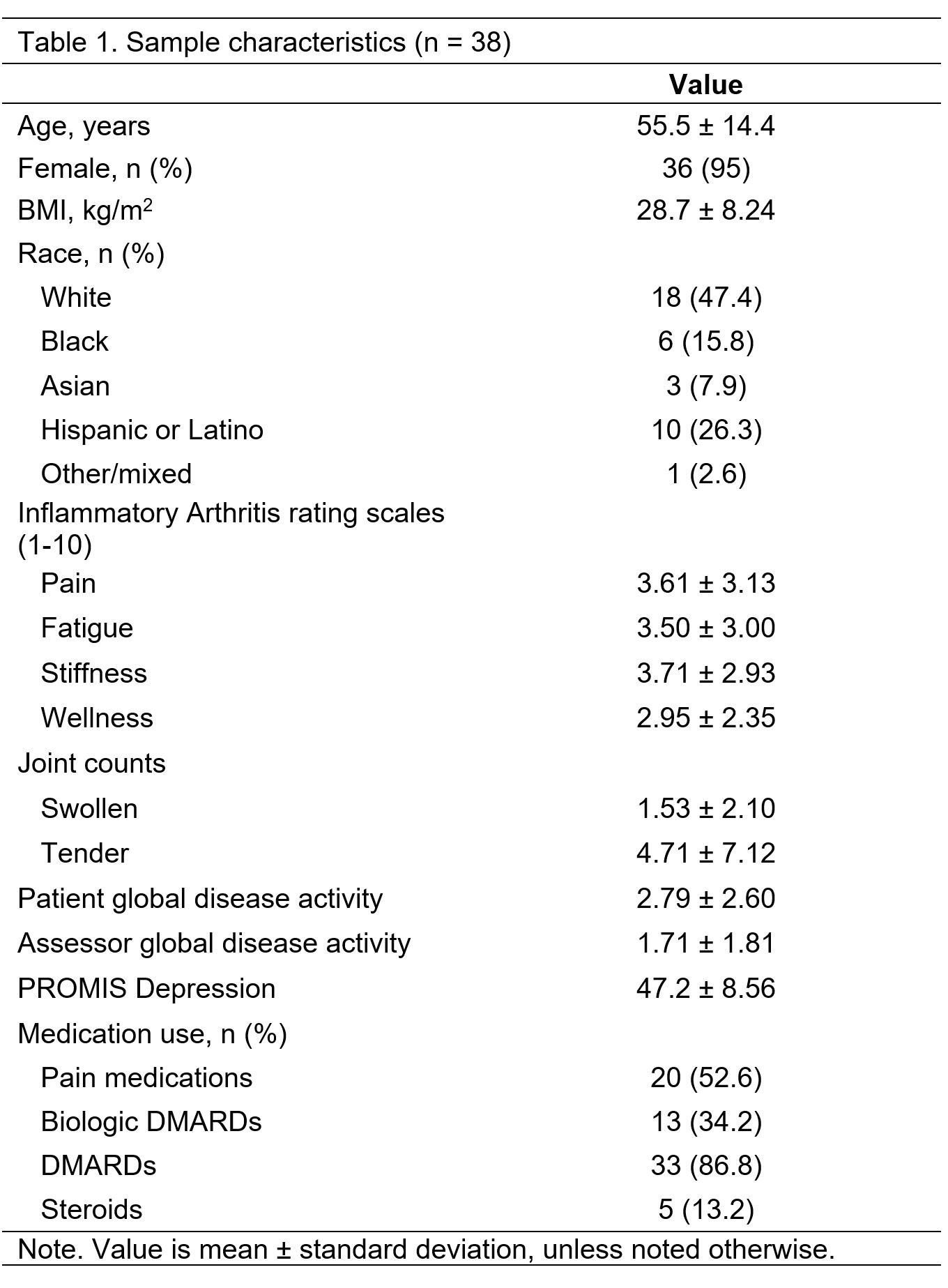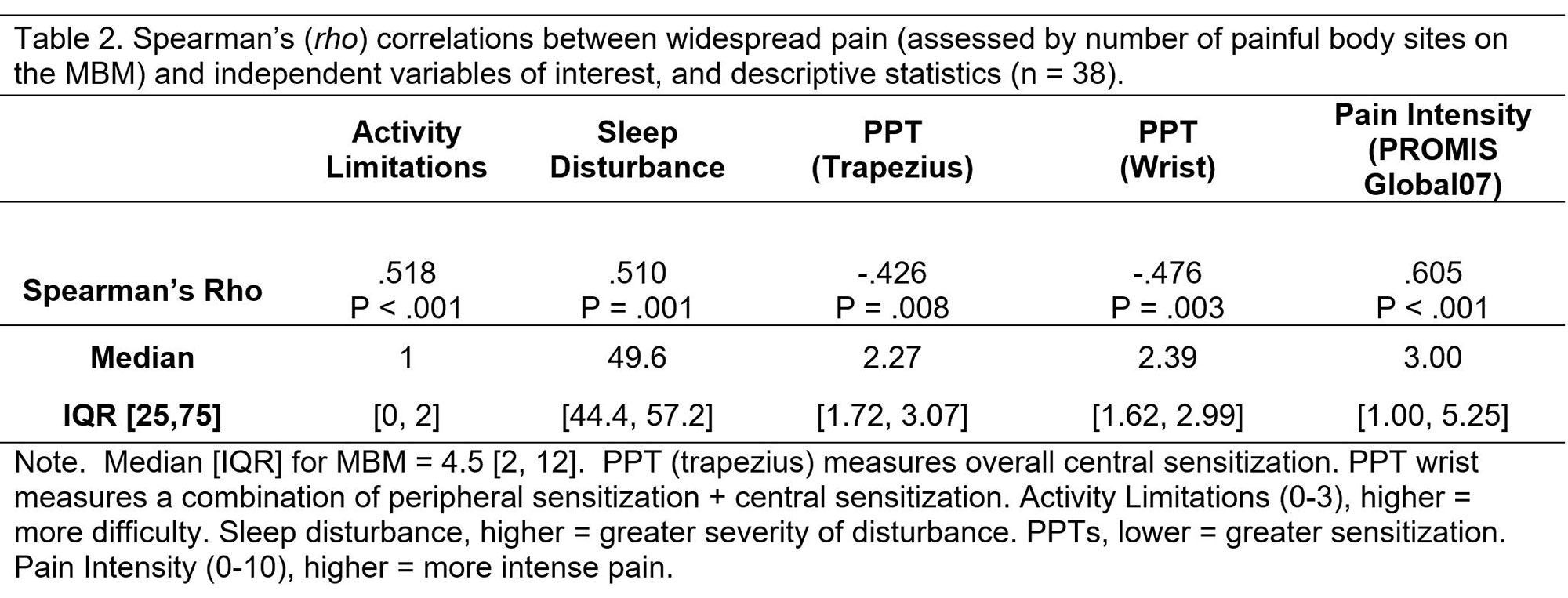Session Information
Session Type: Poster Session D
Session Time: 1:00PM-3:00PM
Background/Purpose: Despite treatment with strong immunosuppressive medications, more than half of patients with rheumatoid arthritis (RA) still report pain. Pain can spread from joint sites to non-joint sites, as patients develop secondary fibromyalgia. Identifying modifiable factors and underlying mechanisms associated with the development of widespread pain could lead to the discovery of effective prevention and/or treatment strategies. The objective of this preliminary analysis was to examine correlations between activity limitations, sleep disturbance, pain sensitization, and pain intensity with self-reported number of painful body sites. We hypothesized that greater activity limitations, severe sleep disturbance, pain sensitization, and more intense pain would be associated with higher number of painful body sites. We also explored correlations between the total number of painful body sites and other measures commonly linked to pain (e.g., age, body mass index, depression).
Methods: Cross-sectional, interim analysis of 38 RA patients in the Sleep, Pain, and AutoNomic function in RA (SPAN-RA) study. Participants met the following major inclusion criteria: age ≥ 18 y/o, meets the ACR/EULAR 2010 criteria for RA. Activity limitations were assessed using an item on the MDHAQ physical function domain that asks respondents to rate the difficulty they had in the past week participating in recreational activities and sports. Sleep disturbance was assessed with the PROMIS Sleep Disturbance Computerized Adaptive Test. Pain sensitization was assessed using an algometer to measure pressure pain thresholds at a nonarticular site (trapezius muscle) and articular site (wrist). Pain intensity was assessed using a 0-10 numeric rating scale. The primary outcome, total number of painful body sites, was assessed with the Michigan Body Map (MBM; score, 0-35). We computed descriptive statistics and calculated Spearman’s rank correlations to address our exploratory hypotheses. A significant alpha was set at P < .05.
Results: The sample was primarily female, and the majority reported being on disease-modifying antirheumatic drug (DMARD) therapy (Table 1). The total number of painful body sites on the MBM ranged from 0 to 23. Greater activity limitations, more severe sleep disturbance, higher pain sensitization, and greater pain intensity were all independently correlated with a higher MBM total score (sum of painful body sites) (Table 2). There were no significant correlations between MBM total score and age (P = .897), body mass index (P = .507), and PROMIS Depression score (P = .271).
Conclusion: Patients with RA who reported a higher number of painful body sites portrayed a phenotypic profile which included greater activity limitations, more severe sleep disturbances, higher pain intensity, and higher pain sensitization. Future longitudinal studies should examine causal pathways between these measures.
To cite this abstract in AMA style:
Aydemir B, Song J, Muhammad L, Grimaldi D, Reid K, Zee P, Chang R, Lee Y. Association Between Activity Limitations, Sleep Disturbance, Pain Sensitivity, Pain Intensity, and Widespread Pain in Adults with Rheumatoid Arthritis [abstract]. Arthritis Rheumatol. 2022; 74 (suppl 9). https://acrabstracts.org/abstract/association-between-activity-limitations-sleep-disturbance-pain-sensitivity-pain-intensity-and-widespread-pain-in-adults-with-rheumatoid-arthritis/. Accessed .« Back to ACR Convergence 2022
ACR Meeting Abstracts - https://acrabstracts.org/abstract/association-between-activity-limitations-sleep-disturbance-pain-sensitivity-pain-intensity-and-widespread-pain-in-adults-with-rheumatoid-arthritis/


